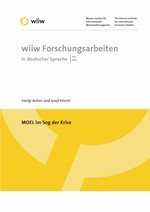MOEL im Sog der Krise (CEECs Falling Prey to the International Crisis)
Vasily Astrov and Josef Pöschl
wiiw Research Report in German language No. 2009-05, May 2009
14 pages including 6 Tables and 6 Figures
(Reprint from: WIFO-Monatsberichte, Vol. 82, No. 5, May 2009)
Zusammenfassung
Die mittel- und osteuropäischen Länder (MOEL) sind spätestens seit September 2008 von der Krise der Weltwirtschaft ebenfalls betroffen. Vor allem die Industrieproduktion und der Außenhandel leiden unter den Folgen des Nachfrageeinbruchs. Das reale BIP-Wachstum verlangsamte sich zunächst deutlich und dürfte mittlerweile in fast allen Ländern von einem Rückgang abgelöst worden sein. Die Verschlechterung der Wirtschaftslage bewirkte eine deutliche Erhöhung der Arbeitslosigkeit. Die öffentlichen und die privaten Haushalte sowie die Unternehmen und Banken stehen unter Druck, der zunehmen wird, sollte die Weltwirtschaftskrise von längerer Dauer sein. Die Unterschiede zwischen den einzelnen Ländern sind jedoch substantiell, da in jedem Land spezielle krisenabschwächende oder -verstärkende Faktoren eine Rolle spielen. Gravierend dürfte die Rezession in jenen Ländern ausfallen, die durch hohe makroökonomische Ungleichgewichte gekennzeichnet sind (Ungarn, baltische Länder) oder eine rückständige Exportstruktur aufweisen (Ukraine).
English Summary
CEECs Falling Prey to the International Crisis
The current global financial and economic crisis has been spilling over to the Central and Eastern European countries (CEECs). After several years of economic prosperity in most of these countries, activities of the real economy have slowed down. The crisis has reached the region on two tracks. More difficult and costly access to borrowing (first track) exerts a negative impact on private consumption, especially with regard to demand for durable consumer goods, such as cars, on private investment (both in construction and equipment), and, finally, on foreign trade. At the same time, CEE exports are suffering from the recession in the EU 15 (second track), above all in Germany, the main trading partner for most of the CEECs. Industrial output and export data both reflect the depth of the economic downturn.
Inflation had been on the rise up to mid-2008, but decelerated afterwards, with cases of zero month-on-month inflation frequently seen in CEECs. At least, this is true for euro countries and countries with a fixed currency peg. In others, the currency depreciated after September 2008, which also led to significant real depreciation. CEECs with notoriously large current-account deficits are in a dilemma, as sources of external financing have become scarce. The same is true for countries where a wide gap between interest rates for domestic and foreign borrowing had seduced the private sector to accumulate large volumes of debt denominated in foreign currency. Governments were bound by fiscal discipline in recent years, but deficits will increase in 2009 and 2010 in an environment of low revenues, high expenditures and high unemployment. Apart from Russia, these countries have only limited means to implement economic stimulus packages. As internal sources will not be able to generate a great deal of additional demand, the CEECs will have to wait for spillovers from an improving business climate in the rest of the world.
Keywords: transitional economies, comparative study, economic growth, fiscal and monetary policy, macroeconomic forecast, macroeconomic analysis
JEL classification: P2, O57, E17, O4
Countries covered: Albania, Bosnia and Herzegovina, Bulgaria, Visegrad countries, Croatia, Czechia, Estonia, Hungary, Kazakhstan, Latvia, Lithuania, North Macedonia, Montenegro, Poland, Romania, Russia, SEE, Serbia, Slovakia, Slovenia, Turkey, Ukraine, Baltic States
Research Areas: Macroeconomic Analysis and Policy, Labour, Migration and Income Distribution, International Trade, Competitiveness and FDI, Sectoral studies
